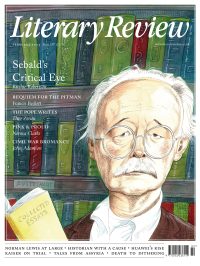James Waddell
A Cut Above
Fragmentary Forms: A New History of Collage
By Freya Gowrley
Princeton University Press 400pp £50
In 1912, Pablo Picasso and Georges Braques reached for their scissors, their glue and a stack of newspapers, and began to snip and stick. And so artistic collage was born. That, at least, is how the traditional history of the subject has it. Of course, the Cubists did not invent cutting and pasting. But, according to the art historian Dawn Adès, their work was groundbreaking because it ‘had nothing to do with popular past-times like pasting cut out images onto fire screens, and everything to do with art’.
Freya Gowrley sets out to recalibrate the history of collage. She writes in the introduction of Fragmentary Forms that the period before the 20th century has often been treated as a ‘kind of strange and slightly quaint dark age’ for collage. Over the rest of this book’s richly illustrated pages, she radically widens collage’s historical and geographical scope, beginning with 12th-century Japanese paper cut-outs and ending with AIDS memorial quilts. She also expands the definition of collage to include all sorts of ‘juxtapositionary practices’. Brought within its compass is anything involving ‘stuff stuck to other stuff’, from shell-adorned grottoes to those much-disdained Victorian fire screens. For Gowrley, collage is not a medium or a genre but rather a ‘mode’, a ‘means of processing the world’.
Using this broad definition, the book rolls over several hoary art-historical borders. Collage, we are told, traverses the boundaries of ‘high’ and ‘low’ art, feminine-coded craft practices and masculine-coded original invention, the ‘modern’ and the ‘pre-modern’. As the title suggests, a contradiction underpins collage. For all that it entails

Sign Up to our newsletter
Receive free articles, highlights from the archive, news, details of prizes, and much more.@Lit_Review
Follow Literary Review on Twitter
Twitter Feed
Under its longest-serving editor, Graydon Carter, Vanity Fair was that rare thing – a New York society magazine that published serious journalism.
@PeterPeteryork looks at what Carter got right.
Peter York - Deluxe Editions
Peter York: Deluxe Editions - When the Going Was Good: An Editor’s Adventures During the Last Golden Age of Magazines by Graydon Carter
literaryreview.co.uk
Henry James returned to America in 1904 with three objectives: to see his brother William, to deliver a series of lectures on Balzac, and to gather material for a pair of books about modern America.
Peter Rose follows James out west.
Peter Rose - The Restless Analyst
Peter Rose: The Restless Analyst - Henry James Comes Home: Rediscovering America in the Gilded Age by Peter Brooks...
literaryreview.co.uk
Vladimir Putin served his apprenticeship in the KGB toward the end of the Cold War, a period during which Western societies were infiltrated by so-called 'illegals'.
Piers Brendon examines how the culture of Soviet spycraft shaped his thinking.
Piers Brendon - Tinker, Tailor, Sleeper, Troll
Piers Brendon: Tinker, Tailor, Sleeper, Troll - The Illegals: Russia’s Most Audacious Spies and the Plot to Infiltrate the West by Shaun Walker
literaryreview.co.uk